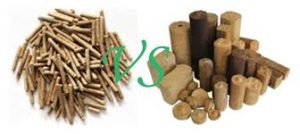A1 Wood Pellets vs RUF Wood Briquettes both are popular biomass fuels used for heating and energy production. Each has its advantages and best suited applications. Let’s compare them:

A1 Wood Pellets:
- Composition: Wood pellets are cylindrical, small, and uniform in size. They are typically made from compressed sawdust or other wood waste without any additives or binders.
- Energy Density: A1 Wood pellets have a high energy density, making them efficient for heating purposes. They have a lower moisture content, typically around 6-8%, resulting in more consistent heat output.
- Ease of Use: Pellets are easy to handle and can be automatically fed into pellet stoves and boilers through hopper systems.
- Cleaner Combustion: Due to their uniformity, pellets burn cleanly with minimal ash production and reduced emissions.
- Availability: Biomass Wood pellets are widely available in many regions and are usually produced in large-scale pellet mills.
RUF Wood Briquettes:
- Composition: RUF wood briquettes are rectangular blocks made from compressed sawdust or wood shavings. They may contain some natural binders, but no chemical additives are typically used.
- Energy Density: While they have a lower energy density compared to wood pellets, RUF briquettes still provide a significant amount of heat.
- Versatility: RUF briquettes can be used in a variety of heating appliances, such as wood stoves, fireplaces, and certain boilers.
- Longer Burn Time: Due to their larger size, RUF briquettes tend to have a longer burn time than wood pellets, which can be beneficial for some heating applications.
- Availability: RUF briquettes are also widely available, especially in regions with a strong tradition of using solid fuels for heating.
Choosing Between A1 Wood Pellets and RUF Wood Briquettes:
- Heating System: If you have a pellet stove or boiler designed specifically for wood pellets, it’s more practical to use pellets. If your appliance is compatible with briquettes, you can consider RUF briquettes.
- Storage Space: Wood pellets are smaller and can be stored more efficiently in a smaller space. RUF briquettes may require more storage space due to their larger size.
- Availability and Cost: Consider the availability and cost of both fuels in your area. In some regions, one may be more readily available or cost-effective than the other.
- Heat Output: If you require high heat output and shorter burn times, wood pellets might be more suitable. For longer burn times and steady heat release, RUF briquettes could be a better choice.
Ultimately, the decision between A1 wood pellets and RUF wood briquettes depends on your heating system, personal preferences, and local availability. Both options offer eco-friendly and renewable alternatives to traditional fossil fuels for heating and energy production. We hope the comparison of A1 wood pellets vs RUF wood briquettes is clear.